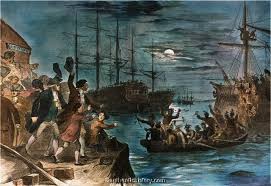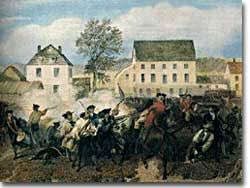This week heralds our Federal income tax deadline - a time that fills most Americans with dread. And no wonder, our nation was founded by men who resisted unjust taxes. The American Revolution was precipitated, in part, by a series of laws passed between 1763 and 1775 that regulating trade and taxes. This caused tensions between colonists and British officials. British unwillingness to respond to
American demands for change allowed colonists to argue that they were part of an increasingly corrupt and autocratic empire in which their
traditional liberties were threatened. This position eventually served as the basis for the colonial
Declaration of Independence.
 |
The Declaration of Independence was the result
of years of political turmoil and outright rebellion |
 |
| Lord Grenville |
In 1763, the British government emerged from the Seven Years' War (French and Indian War in America) burdened by heavy debts. This led British Prime Minister George Grenville to reduce duties on sugar and
molasses but also to enforce the law more strictly. The colonial governments of New York and Massachusetts sent formal letters of protest to Parliament.
To ensure that the colonies did not try to pay for goods and also their taxes in the local script, the British Parliament passed the 1764
Currency Act which forbade the colonies from issuing paper currency. This made it even more difficult for colonists to pay their debts and taxes.
Following the
Currency Act, further Grenville proposed a
Stamp Tax. This law would require colonists to purchase a government-issued stamp for legal documents and other paper goods. In effect, an indirect tax on many things the colonists need to conduct day to day business. Grenville submitted the bill to Parliament for questioning, and only one member raised objections to Parliament's right to tax the colonies.
In response, the Virginia House of Burgesses passed resolutions denying the British Parliament's authority to tax the colonies. In Boston, things heated up. Colonists rioted and destroyed the house of the stamp distributor. News of these protests inspired similar activities and protests in other colonies, and thus the Stamp Act served as a common cause to unite the 13 colonies in opposition to the British Parliament. So in October of 1765, delegates from 9 colonies met to issue petitions to the British Government denying Parliament's authority to tax the colonies. An American boycott of British goods, coupled with a recession, also led British merchants to lobby for the act's repeal on pragmatic economic grounds. Under pressure from American colonists and British merchants, the British Government decided it was easier to repeal the
Stamp Act than to enforce it.
 |
| The Boston Tea Party |
The repeal of the
Stamp Act temporarily quieted colonial protest, but there was renewed resistance to new taxes instituted in 1767 under the
Townshend Acts. Things began to boil as the disgruntled colonists organized. Then in 1773, the colonists staged more vocal widespread protests when the British Parliament granted the East India Company a monopoly on the tax-free transport of tea. The tax-free status of the British East India Company meant that colonial tea traders could not compete. Enraged colonists responded by encouraging a general boycott of British goods. On December 16, 1773, American colonists disguised as Indians boarded East India Company ships in Boston Harbor and threw crates of tea overboard. This famous protest came to be known as the
Boston Tea Party.
When news of the
Tea Party reached England, British officials moved to enforce discipline and order in the colonies. The British Government ordered the closure of the port of Boston until the East India Company was compensated for the destroyed tea. Parliament also passed several pieces of legislation in 1774, which the Americans termed the
Intolerable Acts. British control was further solidified by the appointment of General Thomas Gage as the military governor of Massachusetts. He attempted to place Massachusetts under direct British control.

By 1774, most colonists agreed that a meeting to discuss an appropriate collective response to British actions was a good idea. Colonial legislatures sent representatives to Philadelphia, and the
First Continental Congress convened in September of 1774. The Continental Congress agreed to the
Articles of Association on October 20. These Articles listed colonial grievances and called for a locally-enforced boycott in all the colonies to take effect on December 1. The delegates also drafted a petition to King George III laying out their grievances, although by then they doubted that the crisis would be resolved peacefully.
 |
| General Thomas Gage |
Realizing that further coercive steps would only enrage the colonists and might lead to war, British military governor Gage wrote to London recommending suspension of the Intolerable Acts. Gage hoped to appease many of the colonists and thereby split colonial moderates from radicals. If London was not amenable to his recommendations, Gage stated that he would need significant reinforcements to crush the growing rebellion.
As a reward for his suggestions, Gage was ordered removed from his post. The British government felt that further punitive measures were necessary so Parliament passed additional trade restrictions on New England. London declared the colonies to be in rebellion, but in order to split the resistance, it also offered to stop taxing those colonies that supported the British Government.
 |
| Lexington |
By this time, the most astute leaders from both sides viewed armed conflict as inevitable. Gage's attempts to secure his position in Boston only brought him into conflict with local militias and a hostile populace, and it was only a matter of time until open war began in 1775. The opportunity for peaceful negotiation came to an end, and the war for American Independence began on
April 19, 1775 when British troops and American colonists clashed at
Lexington and Concord.
 |
| Concord |
Later this week (after our taxes are paid), we celebrate the anniversary of the battles at Lexington and Concord...the shot heard round the world...